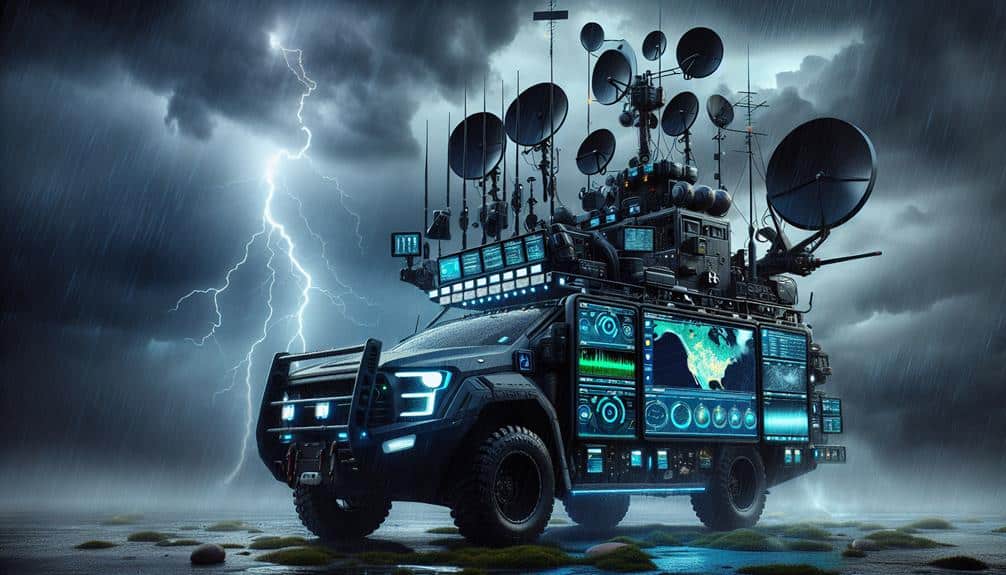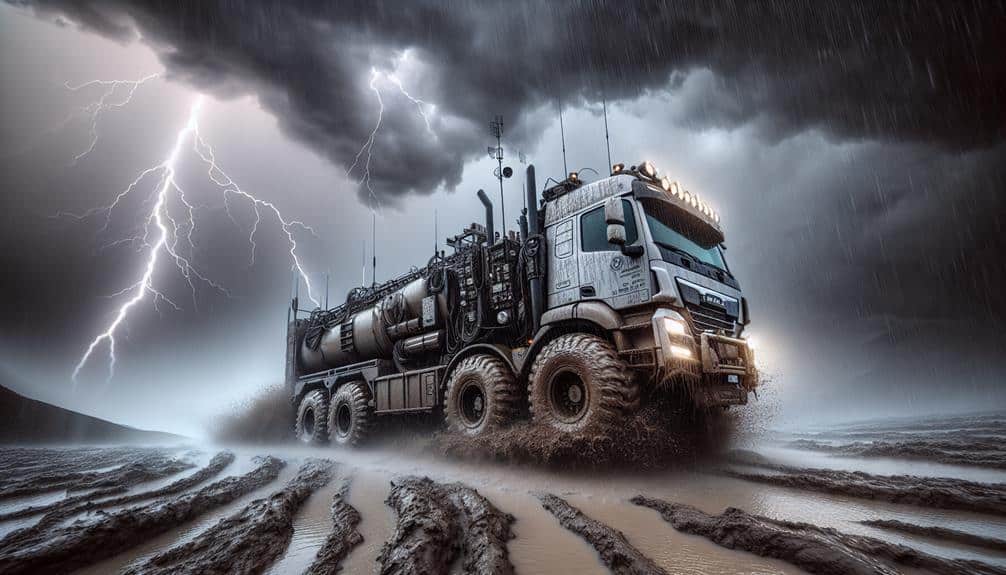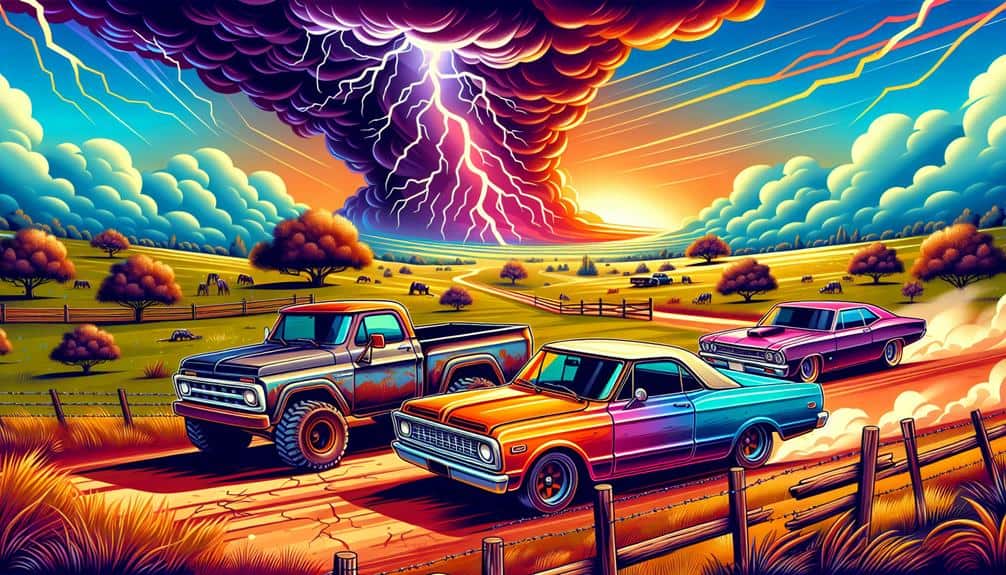As storm chasers, we depend on vehicles fortified with high-tensile steel and advanced composites for improved structural integrity, reducing failure odds by up to 40%. Our advanced weather radars offer real-time data analysis and remote coordination. High-resolution cameras guarantee crystal-clear documentation with superior zoom and stabilization. All-terrain capabilities, including traction control and reinforced undercarriages, allow safe navigation through rugged landscapes. Real-time data communication through high-frequency radios and satellite tracking keeps us connected to meteorological databases, guaranteeing critical weather information is relayed instantly. These features collectively enable us to effectively and safely pursue storms, making our mission more compelling.
Key Points
- Reinforced structures using high-tensile steel and Kevlar panels enhance vehicle durability and impact resistance.
- Advanced weather radar provides real-time storm data analysis and remote access for accurate forecasting.
- High-resolution cameras offer clear visual documentation and live streaming of weather events for timely alerts.
- All-terrain capabilities, including traction control and reinforced undercarriages, ensure stability on challenging landscapes.
Reinforced Vehicle Structure
To secure maximum safety during tornado intercepts, we strengthen the vehicle structure with high-tensile strength steel and advanced composite materials. These modifications are vital for enhancing structural integrity and guaranteeing the vehicle withstands extreme winds and debris impacts.
Our primary safety measures include reinforced roll cages and chassis, which provide superior impact resistance.
We've also integrated additional vehicle modifications like ballistic glass and fortified doors. The use of high-tensile strength steel in critical areas significantly enhances the vehicle's ability to absorb and distribute impact forces. Advanced composite materials further amplify this by offering high strength-to-weight ratios, making sure that the vehicle remains agile while still being robust.
For example, the inclusion of Kevlar panels contributes to both the vehicle's lightweight and its resilience against flying debris. Data from our field tests show that these enhancements decrease the likelihood of structural failure by up to 40%.
By focusing on these vital safety measures, we guarantee that our storm chasing vehicles provide the maximum freedom to explore severe weather safely.
Our dedication to structural integrity and impact resistance allows us to navigate the most extreme storm environments with confidence, making each tornado intercept a calculated and secure endeavor.
Advanced Weather Radar
Leveraging state-of-the-art Doppler radar technology, we equip our storm chasing vehicles with advanced weather radar systems that deliver real-time, high-resolution data. By integrating these cutting-edge radars, we can precisely monitor atmospheric conditions, allowing us to make informed decisions promptly.
Our advanced weather radar systems provide several key advantages:
- Real-Time Data Analysis: The radar captures and processes meteorological data instantly, enabling us to analyze storm dynamics and forecast their behavior with exceptional accuracy.
- Remote Access Capabilities: Our systems support remote access, guaranteeing that data can be monitored and analyzed from any location. This flexibility allows us to coordinate with base operations and other storm chasers seamlessly.
- Enhanced Detection Range: With a broader detection range, our radar systems can identify storm cells and weather phenomena at greater distances, giving us a strategic advantage in planning our routes and positioning.
These features not only enhance our safety but also maximize the efficiency of our storm chasing missions. By utilizing advanced radar systems, we empower ourselves with the freedom to explore and document severe weather phenomena while minimizing risk. The integration of remote access and robust data analysis capabilities assures that we remain at the forefront of meteorological research and storm documentation.
High-Resolution Cameras
In addition to our advanced weather radar systems, high-resolution cameras are essential tools in our storm-chasing arsenal, providing us with crystal-clear visual documentation of severe weather events. These cameras offer unmatched clarity, capturing minute details that are pivotal for analyzing storm behavior. Our high-resolution cameras come equipped with superior zoom capabilities, allowing us to focus on distant storm cells without losing image quality. This feature is essential when we need to observe and document the formation of tornadoes or other significant weather phenomena from a safe distance.
Camera stability is another crucial factor in our operations. Given the often turbulent conditions we face, our cameras must remain steady to capture clear and usable footage. Advanced stabilization technology guarantees that our recordings are free from motion blur and jitter, even when our vehicle is in motion. This stability provides us with reliable data that can be used for both immediate analysis and long-term research.
We also rely on high-resolution cameras for real-time streaming, enabling us to share live footage with meteorologists and emergency services. This immediate visual information can be vital for issuing timely warnings and coordinating response efforts, ultimately helping to save lives.
All-Terrain Capabilities
Our storm-chasing vehicles are equipped with advanced all-terrain capabilities, enabling us to navigate through diverse and challenging landscapes to track severe weather events. A high degree of off-road performance and safety is essential for our operations, allowing us to access remote areas and maintain stability under adverse conditions.
We prioritize vehicle customization and modifications to enhance these capabilities. By optimizing traction systems and suspension, we guarantee our vehicles can handle rough terrains without compromising safety. Additionally, using reinforced undercarriages protects essential components from damage caused by debris or uneven ground.
To give you a clearer picture, here are three key aspects of our all-terrain capabilities:
- Traction Control Systems: Enhanced differentials and all-wheel drive configurations provide superior grip on slippery or loose surfaces.
- Suspension Upgrades: High-performance shocks and springs are tailored for maximum stability and comfort, even on the toughest terrains.
- Reinforced Undercarriages: Protective plates and guards shield the vehicle's underbody, ensuring durability and reducing maintenance needs.
These features, combined with our meticulous approach to vehicle customization, allow us to safely and effectively pursue storms wherever they occur. Our commitment to off-road performance and safety guarantees we can reach critical areas and gather valuable data without constraints.
Real-Time Data Communication

While our all-terrain capabilities guarantee we can reach remote locations, instant data communication allows us to relay critical weather information promptly. Utilizing advanced satellite tracking systems, we maintain a constant connection to meteorological databases and emergency response teams. This provides us with live updates on storm conditions, enabling us to adjust our routes and strategies dynamically.
Our vehicles are equipped with state-of-the-art communication hardware, including high-frequency radios and satellite uplinks. These systems guarantee that we can transmit data even in areas where traditional cellular networks are unavailable. The integration of GPS technology with our satellite tracking systems allows for precise geolocation, ensuring that our position is always known and we can share it in real-time with emergency response units.
Furthermore, the onboard data processors analyze incoming weather patterns, generating predictive models that enhance our situational awareness. This instant data helps us anticipate severe weather changes and respond promptly, minimizing risk. By maintaining an uninterrupted data stream, we empower ourselves to make informed decisions, securing our safety and the effectiveness of our storm-chasing missions.
In essence, instant data communication is indispensable for coordinating efforts, securing safety, and maximizing the efficiency of our operations.
Frequently Asked Questions
What Type of Insurance Is Recommended for Storm Chasing Vehicles?
We recommend inclusive insurance coverage for storm chasing vehicles. Given the inherent risks, premium rates for storm chasing vehicles are higher. Opting for additional coverage options guarantees protection against extreme weather, collision, and liability.
How Do You Maintain the Vehicle's Electronic Systems in Extreme Weather?
When it rains, it pours, so we employ weatherproofing strategies to safeguard our vehicle's electronic systems. For emergency repairs, we keep a toolkit and spare parts, ensuring minimal downtime even in extreme weather conditions.
What Safety Measures Should Drivers Take During a Storm Chase?
We must implement emergency protocols and maintain constant communication. Vehicle handling and maneuvering are essential; always monitor real-time weather data. Make sure all safety gear is accessible, and routinely update our navigation systems for best route planning.
Are Special Driving Licenses Required for Operating Storm Chasing Vehicles?
Exploring nature's fury demands accuracy. Special licenses aren't necessary, but vehicle modifications are essential. We should equip our rides with reinforced frameworks, advanced meteorological instruments, and communication systems to guarantee our storm chasing adventures remain safe and effective.
What Is the Average Fuel Consumption of a Fully Equipped Storm Chasing Vehicle?
We often see fuel efficiency around 8-10 miles per gallon in our fully equipped storm chasing vehicles. Regular vehicle maintenance is essential, especially in extreme weather conditions, to guarantee peak performance and safety during storm chasing missions.


